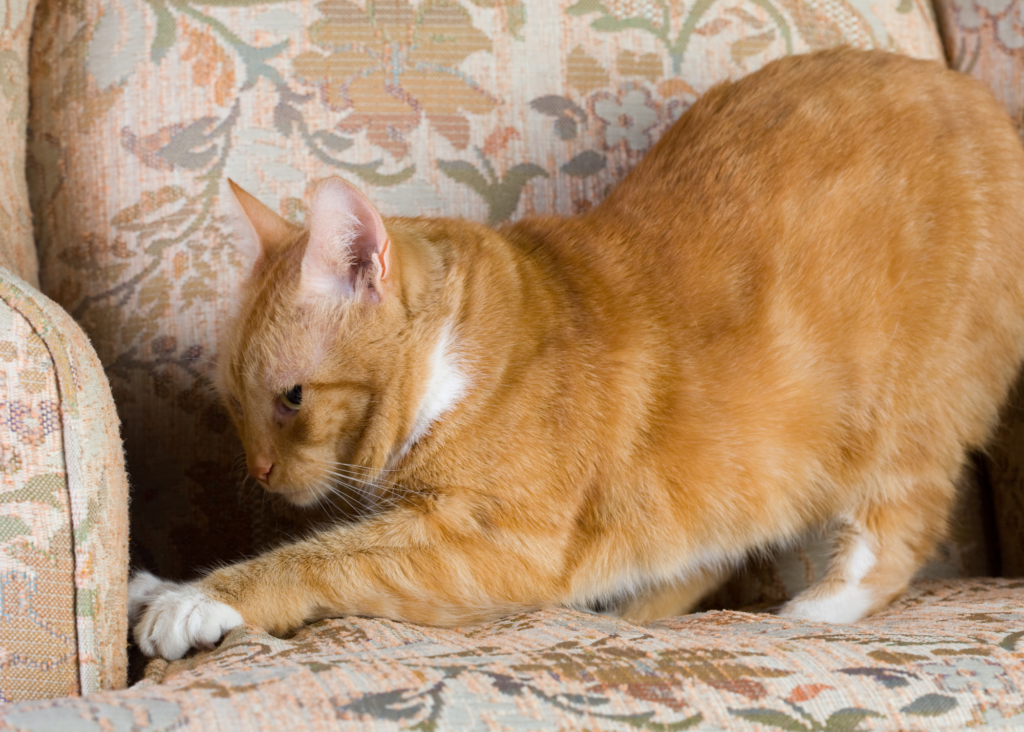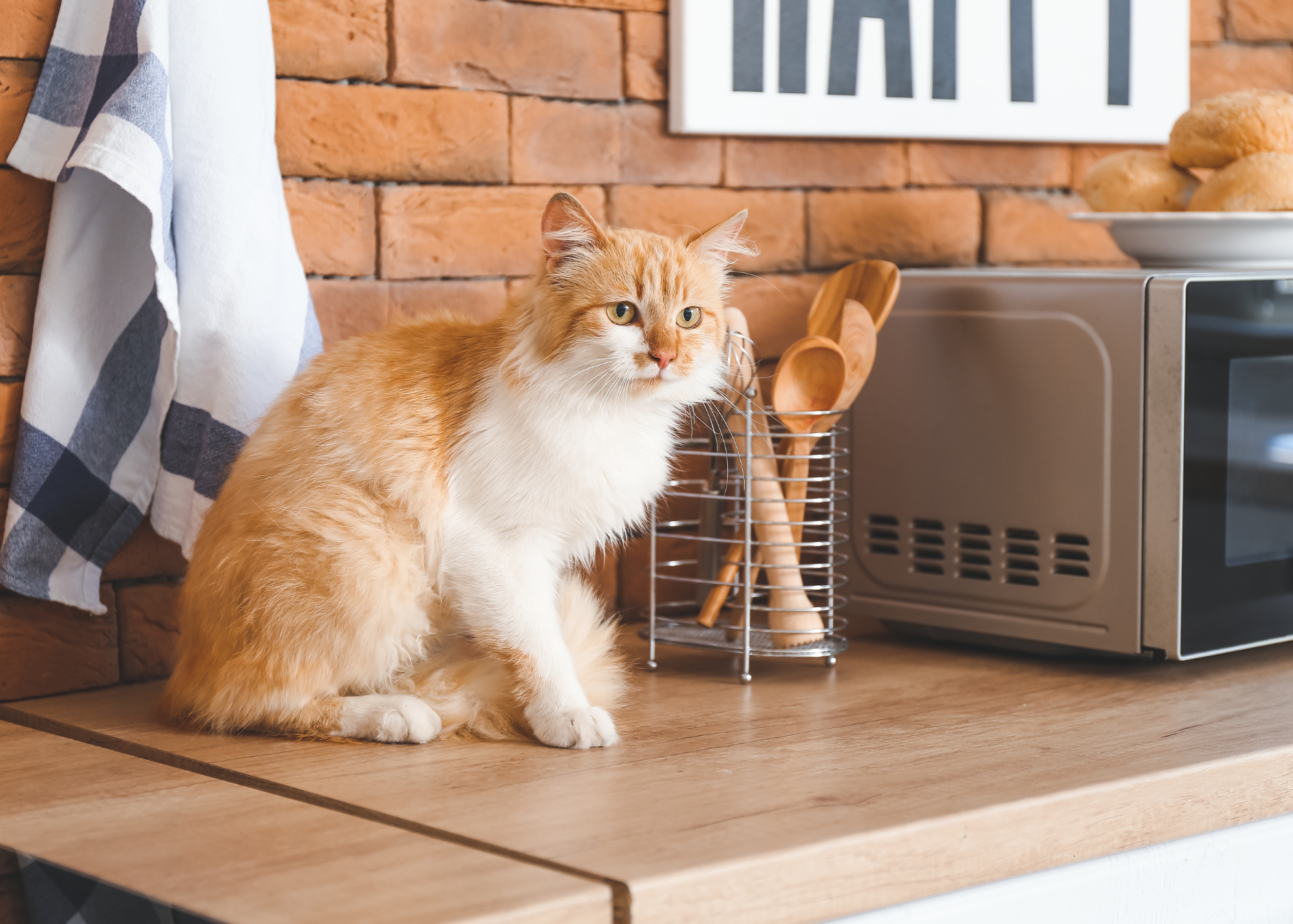How To Stop Unwanted Cat Behavior With Clicker Training
Wanting to stop unwanted cat behavior is a common need. Every few days, a note like this shows up in my Cat School Instagram messages:
“Hey, I like your account, BUT I’m more interested in training my cat NOT to do certain things. I don’t care about teaching my cat tricks.”
Not everyone is as enthusiastic about teaching cats fun behaviors as I am, and that’s okay. If your only goal is to stop your cat’s unwanted behaviors like biting, scratching the furniture, and waking you up in the middle of the night, this post is for you.
Here is my three-step approach to stopping your cat from doing things you don’t want them to do. There is also a chart where I zoom in on how to solve some of the most common problem behaviors cats exhibit.

Steps to Stopping Unwanted Cat Behavior
Step 1: Identify The WTF!
In cat training, WTF stands for “What’s The Function” — not what you were thinking!
What’s the function of the behavior means we need to understand why the cat is doing what they are doing. A cat that jumps on the counter to steal food will need a different training plan than a cat that jumps on the counter for attention.
The other day someone reached out to ask me how to solve their cat’s incessant meowing around feeding time. To help them, I needed to understand if the cat was pushy/mouthy or not fed sufficiently. The latter was the case, and I suggested changing their feeding schedule.
First, identify why your cat is doing the behavior, and then we can work on how to get them to stop.
Step 2: Manage The Situation
Once you establish why your cat is being naughty, it’s time to stop them from getting reinforced for it.
So that means if your cat is jumping on the counter to get food, we need to make sure there is never any food left up there. Let’s say your cat jumps on the counter while you are making dinner. You could prevent this by occupying your cat with a food puzzle while you cook.
A management plan is critical to your success because when your cat practices inappropriate behavior, you will be setting your training back.
Consider playing a slot machine as an analogy to your cat’s behavior. When you play slots, you don’t win every time, but you are motivated to keep playing because of the possibility of winning.
If your cat jumps on the counter and finds food only one out of ten times, that unwanted behavior is going to become even stronger because your cat has learned they need to try at least ten times (or more) to win.
The management step is probably the hardest step to implement because it requires being prepared, monitoring your cat, and getting everyone in the family on board.
Step 3: Clicker Train An Alternative Behavior
Once you are managing the behavior, it’s time to train an alternative behavior.
For problem behaviors like door-dashing and counter-surfing, switch the focus away from what you want your cat to STOP doing and focus on what you WANT them to do instead.
If your cat is jumping on the counter because they want food, one solution is to TRAIN your cat to go to an appropriate spot where they can get food.
Imagine there are two spots available for you to park, parking spot A and parking spot B. Every time you park in parking spot A, someone immediately delivers you a candy bar. When you park in parking spot B nothing happens. Where are you going to park?
We want to create a parking spot for your cat that is better than the counter – a place where they find treats and gets rewards whenever they park their little furry butt there. Once your cat knows the best place to park, you won’t need to worry about them parking in the wrong spot.
Teach your cat what to do INSTEAD of what not to do
What Do I Do When I Catch My Cat Misbehaving?
Now, I know what you are thinking. What should you do if your cat does the thing you don’t want them to do? Depending on what it is, you can ignore them or redirect them.
If your cat is scratching the furniture, you should redirect them to a more appropriate object. If your cat jumps on the counter, and there’s no food, you may want to ignore that until they realize it’s boring and jump off. If you shoo them off, you might inadvertently be reinforcing their behavior because they got something they wanted — your attention.
A word of caution: anything you ask your cat to do AFTER they practice the bad behavior can turn into a chain. For example, let’s say that after your cat jumps on the counter, they jump off. And you want to reward them for jumping off, so you give them a treat. Guess what? You may have taught them a chain: Jump on -> Jump off -> Get a treat. Repeat. You could be accidentally reinforcing the jumping on the counter. Yikes!
Prevention is essential when trying to get rid of problem behaviors! Always reflect on what you could have done to prevent the incident.
Why You Shouldn’t Discipline Your Cat
There are several reasons why you should never discipline your cat with spray bottles, scruffing, or even a firm “NO!”
It is likely that your cat will not equate the action with the behavior and won’t understand why you are doing something hurtful to them. Your cat may associate you with these painful and scary actions and become anxious and fearful around you, deteriorating your relationship.
Telling your cat to stop doing something like scratching doesn’t teach them where they can scratch. Imagine someone telling you, “Don’t do this, don’t do that,” and so on. It can be an incredibly frustrating experience when you don’t understand why someone reprimands you. The same is true for cats.
Another reason not to punish your cat is that it may make them more aggressive. In response to being hurt when you scruff them, your cat may instinctively turn around and bite you.
When you have a battle with your cat, you both lose. Punishment-based methods are a one-way street to hurting your cat. When your only tool is punishment, the only option you have is to punish more intensely.
To improve your cat’s behavior and maintain your connection, focus your attention on reward-based methods and teach your cat acceptable behaviors. If you can’t figure out how to do it on your own, consult with a feline behaviorist. Steer clear from any advice that tells you to use forceful methods.
What’s Next?
Start learning how to train your cat. In my online cat training course, I show you two ways to teach your cat to go to a parking spot, which is a critical behavior to resolving counter-surfing, door-dashing, and improving interactions with multiple cats. Once students have the foundation behaviors in place, I’m always happy to help them get to the finish line with their problem behaviors.
But Really, It Is All About The Tricks
Although we all want quick tips to solve unwanted cat behavior and other issues we have, sometimes the solution involves spending a little time enriching your cat’s life with learning. Many cats exhibit problem behaviors because they are bored. Whether it’s a trick or a practical behavior, it’s all the same to your cat: an opportunity to channel their energy in a fun and rewarding activity.


